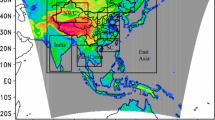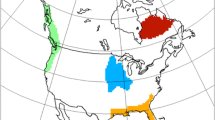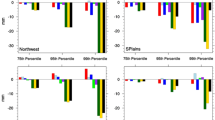Abstract
Regional climate modelling sometimes requires that the regional model be nudged towards the large-scale driving data to avoid the development of inconsistencies between them. These inconsistencies are known to produce large surface temperature and rainfall artefacts. Therefore, it is essential to maintain the synoptic circulation within the simulation domain consistent with the synoptic circulation at the domain boundaries. Nudging techniques, initially developed for data assimilation purposes, are increasingly used in regional climate modeling and offer a workaround to this issue. In this context, several questions on the “optimal” use of nudging are still open. In this study we focus on a specific question which is: What variable should we nudge? in order to maintain the consistencies between the regional model and the driving fields as much as possible. For that, a “Big Brother Experiment”, where a reference atmospheric state is known, is conducted using the weather research and forecasting (WRF) model over the Euro–Mediterranean region. A set of 22 3-month simulations is performed with different sets of nudged variables and nudging options (no nudging, indiscriminate nudging, spectral nudging) for summer and winter. The results show that nudging clearly improves the model capacity to reproduce the reference fields. However the skill scores depend on the set of variables used to nudge the regional climate simulations. Nudging the tropospheric horizontal wind is by far the key variable to nudge to simulate correctly surface temperature and wind, and rainfall. To a lesser extent, nudging tropospheric temperature also contributes to significantly improve the simulations. Indeed, nudging tropospheric wind or temperature directly impacts the simulation of the tropospheric geopotential height and thus the synoptic scale atmospheric circulation. Nudging moisture improves the precipitation but the impact on the other fields (wind and temperature) is not significant. As an immediate consequence, nudging tropospheric wind, temperature and moisture in WRF gives by far the best results with respect to the Big-Brother simulation. However, we noticed that a residual bias of the geopotential height persists due to a negative surface pressure anomaly which suggests that surface pressure is the missing quantity to nudge. Nudging the geopotential has no discernible effect. Finally, it should be noted that the proposed strategy ensures a dynamical consistency between the driving field and the simulated small-scale field but it does not ensure the best “observed” fine scale field because of the possible impact of incorrect driving large-scale field.











Similar content being viewed by others
References
Alexandru A, de Elia R, Laprise R, Separovic L, Biner S (2009) Sensitivity study of regional climate model simulations to large-scale nudging parameters. Mon Weather Rev 137:1666–1686
Anthes R (1974) Data assimilation and initialization of hurricane prediction models. J Atmos Sci 31:702–719
Arakawa A, Konor CS (2009) Unification of the anelastic and quasi-hydrostatic systems of equations. Mon Weather Rev 137(2):710–726
Bannon PR (1995) Hydrostatic adjustment: Lamb’s problem. J Atmos Sci 52:1743–1752
Bao JW, Errico RM (1997) An adjoint examination of a nudging method for data assimilation. Mon Weather Rev 125:1355–1373
Bowden J, Otte T, Nolte C, Otte M (2012) Examining interior grid nudging techniques using two-way nesting in the WRF model for regional climate modeling. J Clim 25:2805–2823
Caldwell P, Chin HNS, Bader DC, Bala G (2009) Evaluation of a wrf dynamical downscaling simulation over California. Clim Change 95:499–521
Cha DH, Lee DK, Kuo YH (2006) An implementation of spectral nudging technique to the WRF model. In: 7th WRF users’ workshop, p 7.3
Davies HC, Turner RE (1977) Updating prediction models by dynamical relaxation: an examination of the technique. Q J R Meteorol Soc 103:225–245
Davies T, Staniforth A, Wood N, Thuburn J (2003) Validity of anelastic and other equation sets as inferred from normal-mode analysis. Q J R Meteorol Soc 129:2761–2775
De Elia R, Caya D, Frigon A, Biner S, Giguère M, Paquin D, Harvey R, Plummer D (2008) Evaluation of uncertainties in the CRCM-simulated North American climate. Clim Dyn 30:113–132
Denis B, Laprise R, Caya D, Côté J (2002a) Downscaling ability of one-way nested regional climate models: the Big-Brother experiment. Clim Dyn 18(8):627–646
Drobinski P, Ducrocq V, Lionello P, the HyMeX ISSC (2009) Hymex, a potential new CEOP RHP in the mediterranean basin. GEWEX Newsl 19:5–6
Dubos T, Voitus F (2014) A semi-hydrostatic theory of gravity-dominated compressible flow. J Atmos Sci. doi:10.1175/jas-d-14-0080.1
Dudhia J (1989) Numerical study of convection observed during the winter monsoon experiment using a mesoscale two dimensional model. J Atmos Sci 46:3077–3107
Flaounas E, Drobinski P, Borga M, Calvet JC, Delrieu G, Morin E, Tartari G, Roberta T (2012) Assessment of gridded observations used for climate model validation in the mediterranean region: the HyMeX and MED-CORDEX framework. Environ Res Lett. doi:10.1088/1748-9326/7/2/024017
Giorgi F, Jones C, Asrar GR (2009) Addressing climate information needs at the regional level: the CORDEX framework. WMO Bull 58(3):175–183
Hohenegger C, Brockhaus P, Bretherton CS, Schaer C (2009) The soil moisture-precipitation feedback in simulations with explicit and parameterized convection. J Clim 22:5003–5020
Hoke JE, Anthes R (1976) The initialization of numerical models by a dynamic initialization technique. Mon Weather Rev 104:1551–1556
Holton JR (1992) An introduction to dynamic meteorology, 3rd edn. International geophysics series, vol 48. Academic Press, San Diego
Hong HMH, Juang S-Yand (1998) Implementation of prognostic cloud scheme for a regional spectral model. Mon Weather Rev 126:2621–2639
Hong SY, Dudhia J, Chen SH (2004) A revised approach to ice microphysical processes for the bulk parameterization of clouds and precipitation. Mon Weather Rev 132:103–120
Hong SY, Noh Y, Dudhia J (2006) A new vertical diffusion package with an explicit treatment of entrainment processes. Mon Weather Rev 134:2318–2341
Kain JS (2004) The Kain–Fritsch convective parameterization: an update. J Appl Meteorol 43:170–181
Kanamaru H, Kanamitsu M (2007) Scale-selective bias correction in a downscaling of global analysis using a regional model. Mon Weather Rev 135(2):334–350
Kida H, Koide T, Sasaki H, Chiba M (1991) A new approach for coupling a limited area model to a GCM for regional climate simulations. J Meteorol Soc Jpn 69:723–728
Kuo YH, Guo YR, Westwater ER (1993) Assimilation of precipitable water measurements into a mesoscale numerical model. Mon Weather Rev 127:1215–1238
Lei L, Stauffer DR, Deng A (2012) A hybrid nudging-ensemble kalman filter approach to data assimilation in wrf/dart. Q J R Meteorol Soc 138:2066–2078
Lo JC, Yang ZL, Pielke RA (2008) Assessment of three dynamical climate downscaling methods using the Weather Research and Forecasting (WRF) model. J Geophys Res 113:D09112
Madden RA (2007) Large-scale, free rossby waves in the atmosphere: an update. Tellus A 59(5):571–590
Miguez-Macho G, Stenchikov GL, Robock A (2004) Spectral nudging to eliminate the effects of domain position and geometry in regional climate model simulations. J Geophys Res 109:D13,104–D13,104
Mlawer EJ, Taubman SJ, Brown PD, Iacono MJ, Clough SA (1997) Radiative transfer for inhomogeneous atmospheres: RRTM, a validated correlated-k model for the longwave. J Geophys Res 102(D14):16663–16682
Omrani H, Drobinski P, Dubos T (2012a) Investigation of indiscriminate nudging and predictability in a nested quasi-geostrophic model. Q J R Meteorol Soc 138:158–169
Omrani H, Drobinski P, Dubos T (2012b) Spectral nudging in regional climate modeling: how strongly should we nudge? Q J R Meteorol Soc 138:1808–1813
Omrani H, Drobinski P, Dubos T (2013) Optimal nudging strategies in regional climate modelling: investigation in a Big-Brother experiment over the European and Mediterranean regions. Clim Dyn 41(9):2451–2470
Otte TL (2008) The impact of nudging in the meteorological model for retrospective air quality simulations. Part I: evaluation against national observation networks. J Appl Meteorol Climatol 47(7):1853–1867
Otte TL (2008) The impact of nudging in the meteorological model for retrospective air quality simulations. Part II: evaluating collocated meteorological and air quality observations. J Appl Meteorol Climatol 47(7):1868–1887
Pohl B, Crétat J (2013) On the use of nudging techniques for regional climate modeling: application for tropical convection. Clim Dyn 43:1693–1714
Radu R, Déqué M, Somot S (2008) Spectral nudging in a spectral regional climate model. Tellus A 60:898–910
Rockel B, Castro CL, Pielke RA Sr, von Storch H, Leoncini G (2008) Dynamical downscaling: assessment of model system dependent retained and added variability for two different regional climate models. J Geophys Res 113(D21):107. doi:10.1029/2007JD009,461
Rogers RE, Deng A, Stauffer D, Gaudet B, Jia Y, Soong ST, Tanrikulu S (2013) Application of the weather research and forecasting model for air quality modeling in the San Francisco bay area. J Appl Meteorol Climatol 52:1953–1973
Salameh T, Drobinski P, Dubos T (2010) The effect of indiscriminate nudging time on large and small scales in regional climate modelling: application to the mediterranean basin. Q J R Meteorol Soc 136:170–182
Skamarock WC, Klemp JB (2007) A time-split nonhydrostatic atmospheric model for research and nwp applications. J Comput Phys 227:3465–3485
Stauffer D, Bao J (1993) Optimal determination of nudging coefficients using the adjoint equations. Tellus 45A:358–369
Stauffer DR, Seaman NL (1990) Use of four-dimensional data assimilation in a limited-area mesoscale model. Part I: experiments with synoptic-scale data. Mon Weather Rev 118(6):1250–1277
von Storch H, Langenberg H, Feser F (2000) A spectral nudging technique for dynamical downscaling purposes. Mon Weather Rev 128:3664–3673
Taylor KE (2001) Summarizing multiple aspects of model performance in single diagram. J Geophys Res 106:7183–7192
Thatcher M, McGregor JL (2009) Using a scale-selective filter for dynamical downscaling with the conformal cubic atmospheric model. Mon Weather Rev 137(6):1742–1752
Vidard PA, Dimet FXL, Piacentini A (2003) Determination of optimal nudging coefficients. Tellus A 55:1–15
Waldron KM, Paegle J, Horel JD (1996) Sensitivity of a spectrally filtered and nudged limited-area model to outer model options. Mon Weather Rev 124:529–547
Zampieri M, D’Andrea F, Vautard R, Ciais P, de Noblet-Ducoudré N, Yiou P (2009) Hot European summers and the role of soil moisture in the propagation of Mediterranean drought. J Clim 22:4747–4758
Zou X, Navon I, Le Dimet FX (1992) An optimal nudging data assimilation scheme using parameter estimation. Q J R Meteorol Soc 118:1163–1186
Acknowledgments
We are thankful to R. Laprise for fruitful discussion. This research has received funding from the ANR-MEDUP project, GIS “Climat-Environnement-Société” MORCE-MED project, and through ADEME (Agence de l’Environnement et de la Maîtrise de l’Energie) contract 0705C0038. It was also supported by the IPSL group for regional climate and environmental studies. This work also contributes to the HyMeX program (HYdrological cycle in The Mediterranean EXperiment) through INSU-MISTRALS support and the Med-CORDEX program (A COordinated Regional climate Downscaling EXperiment—Mediterranean region).
Author information
Authors and Affiliations
Corresponding author
Rights and permissions
About this article
Cite this article
Omrani, H., Drobinski, P. & Dubos, T. Using nudging to improve global-regional dynamic consistency in limited-area climate modeling: What should we nudge?. Clim Dyn 44, 1627–1644 (2015). https://doi.org/10.1007/s00382-014-2453-5
Received:
Accepted:
Published:
Issue Date:
DOI: https://doi.org/10.1007/s00382-014-2453-5




